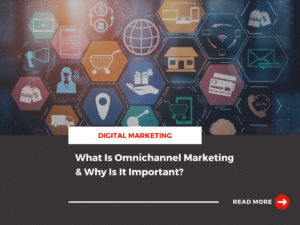If you’re in marketing, you’ve likely heard of the word Omnichannel once or twice. This is more than a buzzword or a tool to help during your brainstorming sessions – it’s the driving force of an award-winning strategy.
According to a study done by Harvard Business Law, 73% of online shoppers prefer to shop through multiple channels. Each channel provides a new opportunity to persuade buyers to purchase and push them through to the end of your customer journey. If you aren’t giving each channel the attention it deserves – you risk losing that connection with your digital consumers.
If you’re new to omnichannel marketing, here’s everything you need to know:
What is Omnichannel Marketing?
Omnichannel marketing refers to the content you create across a variety of channels. This includes apps, social media, email, websites, and offline channels like print ads. Each channel provides your business with a new opportunity and ensures you maximize your potential with every customer and prospect.
When you take an omnichannel approach to your marketing strategy, you’re consistent with the content you create across every channel. You’re sending emails regularly and paying attention to the platforms in your sales funnel that provide the most opportunity.
If you put all of your resources, time, and effort into one channel – it could impact the customer experience and your bottom line.
Omnichannel Marketing vs. Multichannel Marketing
Omnichannel marketing is customer-centric. This means that everything you do from a digital marketing perspective is for your customer, and the goal is to create a seamless, next-level customer experience.
While multichannel marketing has many similarities, this approach is more company-centric. This is when businesses offer customers several different ways to interact with their brand but aren’t dedicated to developing a cohesive, seamless experience. To find success, you’ll want to find a balance between both approaches. Consider your company goals and how they connect with the customer goals.
How The Omnichannel Approach Works
To understand the power and importance of omnichannel marketing, you need to think about every aspect of the customer journey and provide seamless integration at every touchpoint.
Let’s say a new prospect finds your business on Instagram. They look at a few of your most recent social posts and then head to your bio to visit your website.
Once they get to your website, they add a few of your products to their shopping cart, but they aren’t ready to commit to a purchase just yet.
To help persuade them to complete their purchase, you add an exit pop offering a discount on their first order. The shopper fills out the pop-up, and then you continue to market to them by sending a welcome offer and setting them in an abandoned cart series.
With this scenario, we have over three different channels working together to help convert a prospect into a paying customer. You may have never made that initial connection if you didn’t have your social media profile on that platform. However, if you didn’t have your abandoned cart series, you may have never pushed them to make a purchase.
The Importance of Omnichannel Marketing
Personalization and Segmentation
In today’s digital age, personalization and segmentation are must-haves. You can’t expect all your prospects to convert from the same email campaigns, pop-ups, and advertisements. When you segment and personalize your approach, you can build a worthwhile connection with your customers. You can provide them with deals and product offerings they want to take.
Make Data-Driven Decisions
With this digital marketing approach, you can gain a new perspective on your prospective audience. You’ll learn more about consumer behaviors and demographics. Which will allow you to create a more robust advertising strategy that delivers results.
Improve The Sales Funnel
Once you create an omnichannel strategy, you can finetune your sales funnel and find new ways to improve the customer journey. This will ensure you’re bringing in valuable leads that are more likely to convert into paying customers.
Increase Customer Lifetime Value
With the seamless integration of every touchpoint in your customer journey, you can convert your website visitors into paying customers. This also helps you nurture leads and ease them into your customer experience. According to Google, omnichannel shoppers have a 30% higher lifetime value than your regular one-time purchase customers. So while creating this workflow may take time – it will all be worth it.
How to Create an Omnichannel Strategy
1. Create a Buyer’s Persona
To create an omnichannel strategy, you need to first understand your audience. Which social platforms do they use? What brands do they shop with? How do they spend their free time? Questions like these provide insight into consumer behavior, which you can later leverage at every step of your customer journey.
2. Consider the Different Channels Your Audience Uses
There are a ton of different platforms you can focus on. However, if your audience isn’t using every single one, you don’t need to waste time building your presence there.
Most businesses choose a variety of different channels at once. Here are some of the most popular:
- Social Media: Decide which social platform your target audience spends the most time on. Is it Linkedin or Twitter? Instagram or Facebook? Once you dial in which platforms to focus on, you can create a paid ads social media strategy and post regularly.
- Email Marketing: Emails allow you to send your current subscriber list deals, updates, offers, and promotions for your products. These individuals have already shown an interest in your brand and are most likely to make a purchase. Launching an email marketing campaign is easier than you think, and is one of the most effective and profitable digital marketing channels.
- Live Chat: With a live chat on your website, you can answer customers’ questions and concerns in real-time. This will improve the customer experience and help you upsell, cross-sell, and sell your products to potential buyers.
- Text-Messaging: SMS marketing is great for sending customers reminders, deals, and discounts. You can also use this platform to update customers about their shipping and tracking information.
- Push Notification: If you have an app, push notifications can be a great tool to engage with your customers, get them to complete purchases, and take advantage of deals.
That’s only to name a few of the channels you can utilize in your omnichannel strategy. Some digital marketing channels may vary based on business. Your website, content marketing, affiliate marketing, and print advertising are all other worthwhile channels you’ll want to focus on.
3. Utilize Segmentation
Segmentation will help you improve personalization in your cross-channel marketing strategy. When you segment your marketing initiatives, you can create a more seamless experience for the shopper. For example, segmentation may be the abandoned cart workflow you have set up.
When someone leaves their cart, they receive an email reminder to push them to complete a purchase. You wouldn’t send every individual that visits your website that same workflow, though. Instead, you may put them into a workflow based on purchase behavior, a past purchase, or recent searches on your website.
Here are a few examples of segmentation that you can utilize:
- Past purchases
- Abandoned cart
- Purchase behavior
- Recent searches
- Location, age, or gender
- Engagement with email campaigns
- The time of the year
With segmentation, don’t be afraid to think outside the box and to A/B test what works well for your industry. You never know which segment is the most worthwhile for your business.
4. Visualize Your Customer Journey
Once you choose which channels are meaningful and start to segment your approach, it’s time to take a step back and visualize the customer journey. You’ll want to consider your customer’s pain points, where you have the most value add-ins, and which parts of the customer journey you can improve.
Every customer journey is slightly different, but here are some of the most common parts that are included:
- Awareness: Paid ads, social media, SMS marketing, email marketing, print advertising
- Consideration: Content marketing, website, live chat, reviews
- Purchase: Online order, in-person purchase, app purchase
- Loyalty and Advocacy: Leaves a review, shares insight with a coworker, UGC, posts on social media
5. Maintain Consistency
Throughout the customer journey, you’ll want to ensure you stay consistent with your language, word choices, and marketing. This ensures you create a seamless experience at every touchpoint in your funnel. If your brand doesn’t sound like your brand in your SMS marketing versus your social media posts, it will disrupt the buyer’s journey and negatively impact your credibility.
6. Analyze Data and Performance
Once everything moves in the right direction, you’ll want to set time aside to start analyzing your data. You’ll want to do this regularly, on a monthly, quarterly, and annual basis. This ensures you find flaws in your omnichannel marketing approach that you can address and adjust.
You’ll want to pull data from every channel you use to get a clear picture of your success. You can also use Google Analytics and other free omnichannel marketing tools to measure your performance.
Connect with Kanbar Digital to Learn More
Trying to juggle every channel you incorporate into your omnichannel marketing strategy is never easy. At Kanbar Digital, we’re here to help you establish your brand’s online presence across many channels. We’ll help you create a results-driven strategy designed with your customer’s behavior in mind.
To learn more about how we can help, connect with us today.




